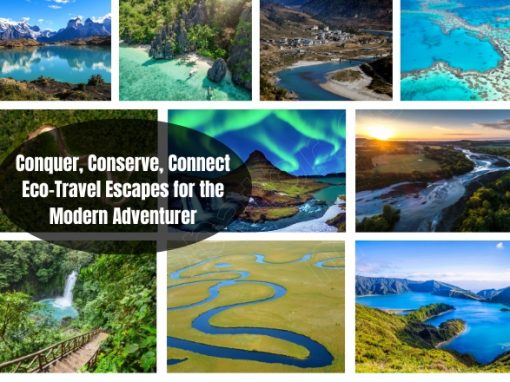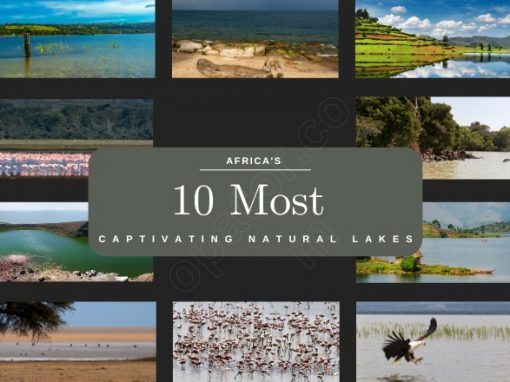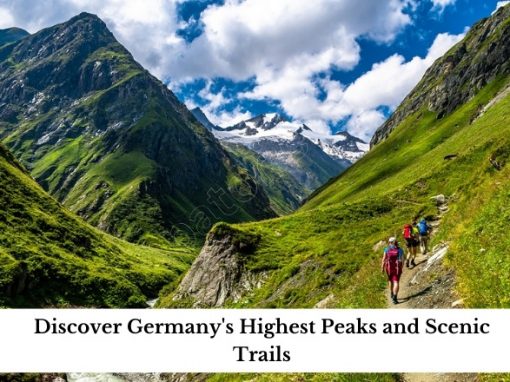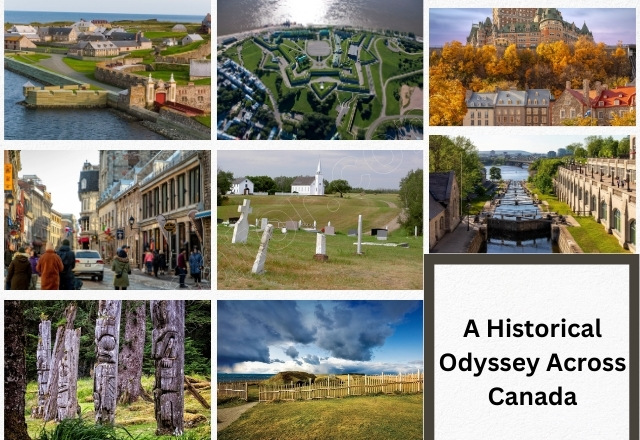
by pankaj kumar | Jun 17, 2024 | Blogs, Country/state/city, Destinations, Travel Tips
Canada, a country best known for its vast terrains and diverse cities, has a long history that is worth learning about. A visit through the historical landmarks is, therefore, important if one is to fully understand the culture of the country. Well then, grab your walking shoes, pack your questions, and let us explore together – through history!
- Fortress of Louisbourg, Nova Scotia: Visit an authentic 18th-century French fortress that was painstakingly restored to its original state. Stroll down the streets and alleys, step inside furnished homes occupied by costumed historical re-enactors, the locals. Picture soldiers exercising in the yard, hear the scent of freshly baked bread coming from the kitchen, embrace the heartbeat of times that were. See musket firing demonstrations and meet soldiers, citizens, and craftsmen who once lived in this imposing building.
- Citadel of Quebec, Quebec City: This star-shaped fort is a UNESCO World Heritage site and was strategically situated on the cliff overlooking Quebec City and the St. Lawrence River. Discover the underground tunnels that are up to 350 years old, and watch soldiers in action to demonstrate how the fort has protected Quebec City from invasions in the past. Discover more about the importance of this fortification and its contribution towards the formation of Canada.
- Old Quebec, Quebec City: Explore the essence of Europe in North America’s only walled city. Walk through a picturesque town featuring 17th-century architecture with its cafés, shops, and artists. Visit Notre-Dame Basilica that has the grand stained glass windows and high ceilings and get a feel of the old world charm. Quartier Petit Champlain is a historical area packed with shops, cafes, and street performers, also charming and unique. Here, one can buy souvenirs of regional manufacture and taste dishes of the national cuisine of Quebec.
- Old Montreal, Quebec: Colonial French influence is seen in the cobblestone roads, horse-drawn carriages, and buildings of historical significance. Visit the Notre-Dame Basilica, an excellent example of the gothic revival style of architecture, and discover the finer points of its design. Have a walk around the crowded area of the Bonsecours Market where artists and producers present their works and goods. Discover more about the city’s history at the Montreal History Centre, where visitors can touch interactives that illustrate Montreal’s past.
- Rideau Canal, Ontario: This 19th-century canal has been listed as a UNESCO World Heritage site being an important transportation artery that connected Ottawa, the capital of Canada, and Kingston. Go on a slow boat ride and see how locks and swing bridges were constructed to facilitate movements across the various water levels. Ride through the spectacular trail which borders the canal; this is a perfect way to have a quiet and serene cycling experience. Take a packed lunch with you and spend some serene time embracing the wild beauty of the area.
- Batoche National Historic Site, Saskatchewan: Travel back in time to 1885 and see the aftermath of the Métis’ rebellion. Some of them are the Métis home, the store, and the school which helps the visitors to get acquainted with the life of the Métis people during this period in the history of Canada. Discover Métis people’s rebellion against the Canadian government and extend your knowledge about the Canadian multicultural history. Visit and step on the territories where people fought for their rights and learn the stories of their fight.
- L’Anse aux Meadows, Newfoundland and Labrador: Step back in time to learn the history of the Vikings who arrived in North America around 1000 AD. Discover the secrets of this UNESCO World Heritage Site and learn about the beginnings of Canada exploration. Follow the path of these Norse sailors and try to grasp the distance they sailed across the Atlantic, and the dreams they had. For those who want to get acquainted with the Viking people better, there is a recreated Viking camp available.
- SGang Gwaay (Ninstints), British Columbia: Discover the astounding mystery of the Haida Gwaii Mortuary Poles that were erected in the eighteenth century. These carved and painted cedar giants were intended to represent family members and as a symbol of the Haida culture and art. Discover their role in the Gwaii Haanas National Park Reserve and Haida Heritage Centre. Get enthralled by the craftsmanship and meanings engraved into these colossal structures and learn more about the Haida people.
These are just some of the highlights of Canadian history. For history lovers, there is York Factory National Historic Site in Manitoba for the fur trade and Barkerville Historic Town that depicts the gold rush in British Columbia. Steam engines are exhibited in the Alberta Railway Museum for rail enthusiasts and for those interested in military, there is the Canadian War Museum in Ottawa.
Whether your history interests are antiquity, medieval, renaissance, or whatever, there’s something for you in Canada. Therefore, get ready and let the explorer in you come out by packing your bag and traveling through time across this great and diverse country. Learn Canada’s history like never before and feel the spirit of history come alive through any of the historical sites in Canada.
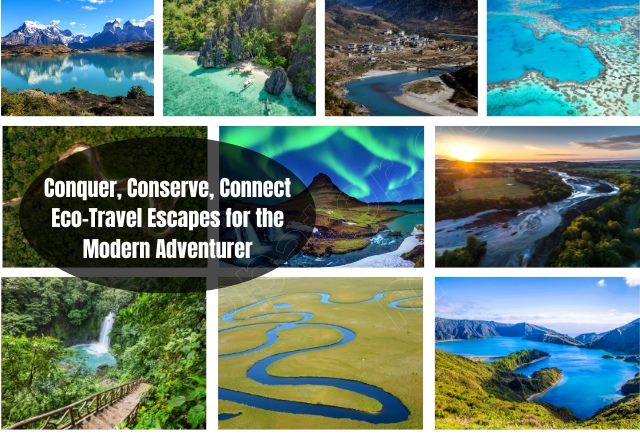
by pankaj kumar | Jun 17, 2024 | Blogs, Country/state/city, Travel, Travel Tips
The spirit of the adventurer in the present-day paradigm is not only defined by successfully climbing a mountain or navigating through a river. It is all about challenging oneself to fulfill one’s potential while taking care of the environment and making the world a better place. This new generation of adrenaline junky hunt for adventure that is both wild and environmentally responsible.
Here are a few eco-travel destinations that perfectly cater to this adventurous spirit
- Patagonia, Chile and Argentina: Trek through the famous Torres del Paine National Park, paddle between glaciers in turquoise blue lakes or go mountain biking through rugged terrain. Patagonia belongs to beginner, intermediate and advanced levels of hiking enthusiasts, but what stands out in this region is its conservation principles in tourism. Nationally parks focus on protection and there are many accommodation options including eco-friendly lodges made from natural materials.
- Palawan, Philippines: Paddle through subterranean streams, swim in the clear waters with fish around reefs, or explore caves and grottos. Palawan is a tropical paradise for adventurers, but it has serious issues, for example, deforestation and pollution. Fortunately, the idea of ecotourism is gaining increasing popularity. Tourists can buy seafood from sustainable sources, patronize establishments that provide employment to locals, and assist in trash removal from coastal areas.
- Bhutan, Himalayas: Hike through stunning landscapes of snowy mountains, meet and watch wild animals including the near-threatened black-necked crane, or visit old monasteries built atop cliffs. Bhutan also has a unique approach to tourism which is known as “High Value Low Impact Tourism’ which means that a small number of tourists are welcome and they are offered quality services that have a positive impact on the environment and community.
- The Great Barrier Reef, Australia: Join a snorkel or scuba trip to explore some of the world’s richest reef systems and an amazing array of marine creatures. Some of the threats currently facing the Great Barrier Reef include climate change and pollution. However, there are other forms of tourism that take into consideration the well-being of the reef. Tourists can decide to participate in noninvasive tours that will help conserve marine life, and get to have an insight into this balance.
- Amazon Rainforest, South America: Take a guided tour through the largest rainforest on the planet and interact with the natives and animals. The Amazon is one of the most important resources in the world, and eco-tourism helps preserve it. People can patronize indigenous-led guided tours, visit eco-friendly accommodations that do not contribute to the deforestation of the area, and be educated regarding the preservation of the rainforest.
- Iceland: Trek across glaciers, watch the beautiful colors of the Aurora Borealis paint the night sky, or relax in geothermal baths. Iceland efficiently utilizes its geothermal features in green energy production, making it a model destination for green tourism. Tourists can opt for environmentally friendly accommodations utilizing renewable energy and visit beautiful territories without disturbing natural environments.
- New Zealand’s South Island: This beautiful island country is a treasure trove of adrenaline-pumping activities that range from bungee jumping to paddling through caves inhabited by bioluminescent glow worms. But New Zealand does not stop at the adrenaline rush. Maori culture is well-represented on the South Island, and visitors get the opportunity to perform Maori dances and get acquainted with sustainable practices inherent in Maori culture. Eco-lodges and good opportunities for volunteering and contributing to the conservation of the great surrounding sceneries add value for the earth-conscious traveler.
- Costa Rica: A leader in ecotourism, Costa Rica offers adrenaline rushes and natural beauty to those who seek it. You can explore volcanoes, and rainforests full of unique wildlife, float down the rapids, or explore the caves that are not exposed to the public. Environmental conservation is an integral part of tourism in Costa Rica since it aims to protect its rainforests and other ecosystems. Tourists can be accommodated in hotels that have renewable energy sources and visit parks with a policy of environmental protection.
- Botswana’s Okavango Delta: This is a World Heritage Site according to UNESCO, and it is a perfect place for wildlife lovers. Go for a trip in a mokoro, a traditional dugout canoe, along the water channels of the delta and expect to see elephants, hippos, and literally any bird that you can imagine. Botswana has perhaps one of the most responsible tourism policies and measures to ensure the protection of wild animals and its environment. There are luxurious eco-camps that provide good accommodation without interfering much with the balance of this sensitive environment.
- The Azores, Portugal: This chain of islands located in the middle of the Atlantic Ocean is every adventurer’s dream. Activities include canyoneering through verdant canyons, surfing gigantic Atlantic waves, or enjoying a kayak cruise through secluded bays. The Azores is an environmentally conscious island with the main emphasis on marine and volcanic park conservation. There are many options for tourists to stay in environmentally friendly lodgings and contribute to the local communities’ sustainable tourism income.
These places are just a few – the globe teems with terrific secrets that provide an excellent mix of fun and sustainability. Thus, forget the popular tourist destinations, enjoy the wild spirit, and go on an unforgettable trip where your heart and adrenaline rush will help improve the world we live in.
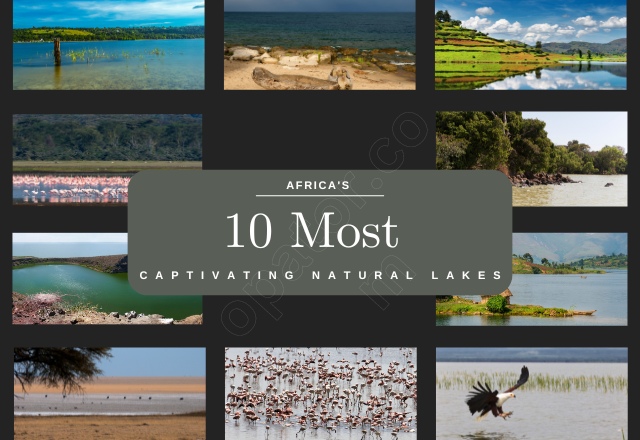
by pankaj kumar | Jun 17, 2024 | Blogs, Country/state/city, Destinations, Travel, Travel Tips
Besides vast areas of savannas and towering mountains Africa, the birthplace of humankind, has an ample number of beautiful natural lakes. These are the most important sources of water for the continent; supporting life in different forms and offering tourists amazing experiences. Here’s a deeper dive into 10 of Africa’s most captivating natural lakes
- Lake Victoria (Kenya, Tanzania, Uganda): The largest freshwater lake in Africa and the second largest in the world, Lake Victoria is known as the crown jewel of Africa. Picture yourself on a boat cruise where you come across a network of beautiful islands with colors of birds galore. You may even be lucky to spot the shoebill stork, a bird that has been listed as endangered due to its huge wingspan of more than eight feet.
- Lake Malawi (Malawi, Mozambique, Tanzania): Lake Malawi National Park is a World Heritage site attracting divers and snorkelers. Popular for various species of brightly colored cichlid fish, it boasts of its clear waters that give a real taste of a tropical fish tank. Just picture the coral gardens crowded with hundreds of species of these bright fish, every one of them different in color patterns and movements.
- Lake Bunyonyi (Uganda): Known as “The Place of Little Birds,” Lake Bunyonyi has always been a calm and serene place. The lake is inhabited by numerous islands, some of which are veiled with legends, and the possibility to relax is beyond competition. Paddle through the calm waters towards the shores of the green hills silhouetted on the water’s surface. Hear the sounds of the numerous bird species, that gave the lake its name.
- Lake Nakuru (Kenya): This Great Rift Valley’s alkaline lake is a photographer’s delight. J Just think of a moment when you can see thousands of flamingos in bright pink color feeding by the shore and what an unforgettable sight this is! Besides, the national park that surrounds the landscape accommodates many wild animals ranging from tall giraffes, powerful lions, and playful black rhinos.
- Lake Tana (Ethiopia): Located in the highlands of Ethiopia, Lake Tana is the origin of the Blue Nile, which is one of the major branches of the Nile River. Great monasteries founded on islands and ancient churches located along the coastline give a glimpse of the historical past of Ethiopia and its deeply rooted religious culture. Cruises are also an opportunity to view not only the familiar hippopotamuses but also bird species that can be found nowhere else, making the lake even more special.
- Lake Turkana (Kenya): Known as the ‘Jade Sea’ due to its greenish-blue hue, Lake Turkana is a rather unforgiving but stunning location. This lake is so far as the eye can see and it is home to birds such as flamingos, pelicans and many more. The landscape here presents an insight into the birthplace of mankind with fossils still being unearthed and the area is a blend of natural beauty and scientific history.
- Lake Kivu (Democratic Republic of the Congo, Rwanda): Located in between Rwanda and the Democratic Republic of the Congo, Lake Kivu is a sight to behold. Lying between towering volcanic ranges with steep slopes that touch the water’s edge, the lake has space for recreation on sandy shores. Savor the stunning views from the water, or go ashore to walk through the lush vegetation that surrounds the calm clear waters.
- Etosha Pan (Namibia): While it is actually a large, shallow, interior drainage depression or salt pan, Etosha Pan presents an unusual water experience. During the rainy season, water accumulates in the pan changing the scenery into a perfect photoshoot backdrop. Envision extensive plains of water, mirroring the pink fluffy clouds in the sky; the ecology of this area welcomes diverse animals such as zebras roaming the plains, springboks jumping off tall grass, and flamingos wading at the shores of the water body.
- Lake Manyara (Tanzania): This is a shallow alkaline lake in Tanzania’s Manyara National Park that is known for the lions that climb trees. Picture finding a pride of lions taking a nap in the branches of acacia trees – this is only possible in this area. The park also presents various wild animals such as elephants raising their voices, hippos sunning themselves in the mud and various colored birds flying from trees.
- Lake Baringo (Kenya): This is a freshwater lake located in the central Rift Valley region of Kenya and is a birders’ paradise. The lake is also home to over 450 species and one of them is the Baringo goose, which is a flightless bird that is also an endangered species. Cruises offer chances to observe the enormous hippos floating in the water as well as a crocodile occasionally lying on the bank. Hot springs and waterfalls also make the region beautiful besides being an important ecological area, making Lake Baringo unique.
These are just some of the many marvelous natural lakes that can be found on the African continent. Every lake is a different opportunity to be met by fascinating fauna and flora, stunning landscapes, cultural landmarks, and archaeological sites.

by pankaj kumar | Jun 17, 2024 | Blogs, Destinations, Travel, Travel Tips
Uttarakhand, blessed with the natural beauty of the Himalayas, is a fitting recipient of the title “Devbhoomi,” the Land of the Gods. Mountains that touch the sky, rivers that roll their verses of nature, and temples that narrate stories of believers—Uttarakhand is a pure pilgrimage for those who seek divine power, natural beauty, and serenity. Check out these 10 magnificent pilgrimage places in the state of Uttarakhand and the spiritual experiences that await you at each one.
- Char Dham Yatra: Experience the most spiritual journey of Hindus and visit the Char Dham Yatra. This sacred trail includes four majestic shrines, each dedicated to a different facet of the divine. Visit the origin of the Ganga at Gangotri and the Yamuna at Yamunotri. Go to the sacred shrine of Kedarnath, the temple of Lord Shiva residing in the great Himalayas. Finally, pray to Lord Vishnu in his divine abode at Badrinath. This journey is not just an act of religious devotion but an arduous journey that challenges your strength of body and mind while steeping you in Indian mythology.
- Haridwar: Often regarded as one of the seven sacred cities of Hinduism, Haridwar is the place where the holy Ganges River flows downward from the Himalayas. Experience the beautiful events of Ganga Aarti at Har Ki Pauri, which is performed during the evenings when tiny lamps float on the river, causing a sight that is both beautiful and spiritual. Take a walk through lively streets filled with temples and markets, feel the spiritual energy, and join the ceremonies that have been held on these grounds for millennia.
- Rishikesh: Situated in the lap of nature at the edge of the Himalayas, Rishikesh is known as the ‘Yoga Capital of the World’. Ancient Yoga and Meditation centers and ashrams provide an alternative way to explore the spiritual self. Performing yogasanas (postures) as old as civilization is possible here under the supervision of master trainers or just let your soul wander with the flow of your breathing by the side of the sacred river. In the evening, go for Ganga Aarti at Triveni Ghat, as the Ganges meets with two other holy rivers here which adds to the spiritual aura.
- Jageshwar: Jageshwar, nestled in the Deodar forests, has much to tell about a period that prevailed in the prehistoric time. Visit a chain of more than one hundred historical temples filled with masterful carvings and exciting stories. Stroll around the structure and be filled with awe at the design and the aesthetic of a civilization from centuries earlier. Jageshwar is not simply a series of temples; it is a glimpse into the socio-cultural legacy of the region of Uttarakhand.
- Hemkund Sahib: Go for a thrilling and adventurous tour to Hemkund Sahib, a holy Shrine of the Sikhs situated in the Himalayas. This Gurudwara is situated in the midst of imposing glaciers and colorful pastures and therefore provides breathtaking views and serenity. Step into the calm environment of this temple, which reflects the fundamentals of the Sikh religion and its values of community, worship, and tolerance. Hemkund Sahib stands as proof that faith can overcome any barriers, and this place, surrounded by stunning nature, unites different people, giving them hope and comfort.
- Tungnath: Test your adventurous soul by having a trek to Tungnath, known to be the highest temple of Lord Shiva on earth. From alpine meadows dotted with wildflowers to steep paths and ridges, experience the breathtaking vistas of the Himalayas here. Reaching the temple, which is a structure made of stones believed to be the shoulders of Lord Shiva, is a satisfying feeling. Located in one of the most scenic places in Uttarakhand, the physical activity of reaching the top and the internal atmosphere of the temple make it an awesome experience.
- Neelkanth Mahadev: Situated on a mountain slope near Rishikesh, Neelkanth Mahadev Temple attracts travelers and explorers of all kinds. The complicated trail in beautiful surroundings provides an opportunity to be with nature. When you get to the temple, which is considered the neck of Lord Shiva, admire the beauty of the area and the relative calmness of the place. The trek to Neelkanth Mahadev temple itself is quite challenging, but the view of the unparalleled beauty and religious vibes is worth it.
- Gaurikund: Gaurikund is the base camp for one of the most challenging treks to Kedarnath, the abode of Shiva. Located in Uttarakhand, in the lap of the Himalayas, Gaurikund is one of the most important pilgrimage sites for Hindus, situated at a place where Goddess Parvati is said to have meditated to win over Lord Shiva. Before starting the steep climb, take a bath in kund, the natural pool, and shiver under mountain water, leaving behind all the worldly concerns before starting the spiritual trek.
- Badrinath: Your Char Dham Yatra ends at Badrinath, which is located in the Garhwal Himalayas. Paying homage to Lord Vishnu in his manifestation as Badrinarayan, the temple of Badrinath is a marvel of architecture that has stood centuries of tests by both time and the forces of nature. Here, amidst the beauty of mountains and in the serenity of the temple and the enchanting music of the pilgrims, one feels blessed. The sight of the beautiful sunrise with peaks covered in snow and the temple changing its color to gold is certainly unforgettable.
Bonus: Valley of Flowers: Uttarakhand observes religious sites which are not simply confined to temples and pilgrimages. Visit the UNESCO World Heritage Site, famously known as the Valley of Flowers. Get lost in a sea of colors as you roam through some of the most stunning meadows with indigenous alpine flowers. The valley covered in natural beauty brings a feeling of serenity and allows one to feel the divine in the world.
Uttarakhand invites you to a spiritual journey that is beyond the realms of the physical world. It is the audacious undertaking that recharges the body, satisfies the soul, and etches on the spirit. It is time to unveil the heavenly canvas that is Uttarakhand and come to a realization about who you are within.

by Opator | May 30, 2024 | Blogs, Destinations, Travel, Travel Tips
While fairy-tale castles and dense forests are common features of the German landscape, there are spectacular mountains as well. From the snow-capped Alps to the rolling Mittelgebirge, the region has something for every type of climber and explorer. Here’s a list of the top 10 German mountain peaks and experiences to add to your bucket list:
- Zugspitze: Roof of Germany
The undisputed monarch of Germany’s highest summits is Zugspitze, which stands at a height of 2,962 meters. This magnificent colossus provides amazing views, which can be reached by cable car for tourists or by steep trails for the thrill-seekers. Reach the peak and step onto the summit of “Germany’s roof”!
- Watzmann: The Bavarian Challenge
Watzmann, the king of the Bavarian Alps, is a group of mountains having three main summits, namely Mittelspitze, Südgipfel, Hocheck, which are challenging for professional climbers. The east face remains a daunting spectacle even for persons who do not climb, although there are several walking paths crisscrossing this magnificent elevation.
- Hochwanner: Allgäu Majesty
Located in the Allgäu Alps, Hochwanner provides marvelous views of the valleys and the Zugspitze in the distance. There are several hiking options: the most beautiful and at the same time one of the most difficult is the Teufelsgrat (Devil’s Ridge). For those who do not want to hike, a cable car takes people to a viewpoint near the top of the mountain.
- Schnefernerkopf: A Climber’s Playground
Another peak close to Zugspitze, Schnefernerkopf attracts experienced climbers because of its difficult north face. But great scenery and interconnected good trails also make it a great place to hike for. Discover the fantastic scenery of the rough wilderness of Germany’s second-highest peak.
- Eibsee: Jewel of the Mountains
Although Eibsee is not a peak but rather a lake surrounded by mountains. This impressive lake lies tucked in a mountainous region and is ideal for photographers, tourists who want to take a break after climbing other mountains. You can either take a boat ride along the transparent water body or go for cycling across the villages on the lake.
- Feldberg: Black Forest Bliss
Feldberg is actually the highest mountain in the Black Forest and it attracts tourists throughout the year. During winter, people engage in skiing, and in summer, people engage in activities such as hiking and mountain biking among others. The Feldberger Steig is a steep bridle path that starts right in the middle of the Black Forest and is recommended only for experienced hikers.
- Brocken: Harz Mountain Mystery
Legend and mystery accompany the Brocken, which is the highest point of the Harz Mountains. This misty mountain peak can be reached by this old-fashioned narrow-gauge railway, which has always been interesting and captivating. Meet the flora and fauna of the mountaintop plateau nature reserve and visit the place where under certain weather conditions, a man’s shadow seems to have a giant head – the Brocken Spectre.
- Großer Arber: Bavarian Forest Family Fun
Großer Arber is also family-friendly and is located in the famous Bavarian Forest region of Germany. A cable car lifts people to the summit where they can view the scenery, trek, or enjoy a canopy bridge. Visit Bavarian Forest National Park which is full of beauty and wildlife and the ancient trees and breathe in the mountain air.
- The Rakotzbrücke (Rakotz Bridge): Devilish Delight
Although not a mountain peak itself, this curious bridge near Kromlau should not be missed by any traveler to Germany. Known as the “Devil’s Bridge,” it forms a circular reflection of the bridge on the water beneath when seen from a certain position. Visit the nearby Kromlau Rhododendron Park, a marvel of park design, and find places of interest such as waterfalls and cottages tucked into the surrounding woodlands.
- The Rheinsteig: Hiking Above the Rhine
This renowned 310-kilometer thru-hike trail runs on the east side of the Rhine River. Highlights include breathtaking views of the Rhine Valley, picturesque towns, and fascinating medieval fortresses, which makes it a great way to admire the area. Trek up through the vineyard, forest, and picturesque villages which will provide a view of the medieval castles towering over cliffs above the river.
Germany is actually replete with mountains besides the ten ones mentioned above. For instance, the Harz Mountains National Park has a well-connected system of hiking and biking trails, picturesque mountain towns like Wernigerode, and historic attractions like Quedlinburg’s medieval mountain castle. The Fichtelgebirge Mountains consist of winter sports facilities and nature parks, and the Ore Mountains are characterized by mining culture and traditional houses.
Therefore, put on your hiking shoes, pack your backpack, and get in the mood for walking through the rocky landscapes of Germany. Given the variety of terrains, steep ascents, and breathtaking views, Germany is a perfect destination for every mountaineer.

by Opator | May 30, 2024 | Blogs, House and Garden
Flower gardens are truly a wonderful oasis of spectacular colors, enchanting fragrances, and beautiful trails in a well-planned layout. From the ancient Monasteries to modern structures, these gardens capture the beauty of gardening and floral arrangement. Here’s a glimpse into 10 of the world’s most stunning flower gardens
- Keukenhof, Netherlands: Also referred to as the Garden of Europe, Keukenhof has more than 7 million flower bulbs planted on its 32 hectares. Tulips, hyacinths and daffodils come in millions and bloom beautifully in the spring season. Thinking about strolling through acres of flowers of all colors from white to red to yellow is like a painting by Monet.
- Gardens of Versailles, France: Take a trip to the Gardens of Versailles and move through time to the majestic French Baroque period. Rows of beautiful trees, well-trimmed hedges in geometrical shapes, and large, bright flower gardens stretch over 200 acres and add to the grandeur of the palace architecture. Imagine walking through smooth pavements surrounded by bushes with roses and lilies, a feeling as if you are walking back in time to the age of luxury.
- Dubai Miracle Garden, United Arab Emirates: Capture a burst of vivacious colors and artistry at the Dubai Miracle Garden. Featuring over 150 million flowers and floral creations in the shapes of animals and castles, this garden presents a colorful and diverse experience with natural beauty. Expect to see grand floral structures such as arches while flowers are laid down on the ground as carpets.
- Humble Administrator’s Garden, China: Take a trip through the history of the Humble Administrator’s Garden which has been listed under UNESCO’s World Heritage list. Established in the 16th century, the beautiful Chinese garden has ponds with Koi fish, arched bridges, pavilions, and flowers that are well arranged in a manner that they are changed to match the seasons. Picture a walk through twisting alleys, the soft string of water spewing from the fountains, and the soothing aroma of peonies blooming nearby.
- Kenroku-en, Japan: Visit one of Japan’s most famous gardens, Kenroku-en, which translates to the “Garden of the Six Substantial Things. “ Admire beautiful koi ponds that reflect the heavens, dainty bridges that overlook lovely scenes, and absorbing blossoms of different seasons. Every single item is positioned and created with the intention of bringing about this feeling of unity and order in a context that encourages tranquility.
- Butchart Gardens, Canada: Butchart Gardens is situated on Vancouver Island and it boasts of flowers virtually all through the year. Some interesting attractions that one should not miss out on are The Sunken Garden; a picturesque quarry transformed into a floral paradise with beautiful flowers in full bloom. picture walking through a number of garden-themed areas in which each represents a burst of different colors and feelings from the beautiful Rose Garden to the specially designed Japanese Garden.
- Nong Nooch Tropical Botanical Garden, Thailand: Nong Nooch offers a look into different plant species to found in the Southeast Asia region. This is a 500-hectare garden where there are beautiful gardens for bonsai trees and orchids, cactus gardens where one can find a variety of plants that exist in the desert and probably the most interesting part there are dinosaur motifs surrounded by flowers. Feel how vivacious and inviting the environment is with the gentle aroma of plumeria flowers and the sounds of unknown birds.
- Singapore Botanic Gardens, Singapore: Located in the heart of Singapore is the Singapore Botanic Gardens which features the National Orchid Garden, featuring over 70,000 orchids including 1,200 species and 200 hybrids. Founded and recognized as a UNESCO World Heritage site, visitors are taken through the tropical rain forests filled with green foliage, ginger gardens comprising of the spice of ginger lilies, and various other themes of the botanical marvels of different continents.
- Kirstenbosch National Botanical Garden, South Africa: Explore more of the nature-endowed South Africa at Kirstenbosch. Overlooking Table Mountain, which is a World Heritage site too, this garden is home to South African indigenous plants such as proteas infusing other-worldly aesthetics to the land and fynbos, a heath and shrubland containing some of the richest plant diversity in the world. There is nothing quite like admiring the majesty of the mountain while being surrounded by the beauty of the flowers and the smell of proteas and fynbos.
- Incarnate Word Chapel & Gardens, United States: Discover serenity and beauty at the Incarnate Word Chapel & Gardens in San Antonio, Texas. The chapel, which hosts functional stained glass that portrays different episodes from the bible, is well enclosed by beautiful gardens with seasonal plants and flowers perfect for meditation and prayer. Suppose one goes out for prayer in the chapel and comes out to find oneself surrounded by the soft smell of roses and the sound of a fountain.
This list only shows a few examples from all the breathtaking flower gardens of the world. Therefore, put on your comfortable shoes, expect to be amazed by floral marvels, and join this colorful journey through these marvelous creations and fantastic manifestations of people’s inspiration and the eternal gifts of nature.

by Opator | May 29, 2024 | Blogs, Travel, Travel Tips
Germany, filled with scenic castles, picture-perfect villages, and magnificent scenery, is the epitome of a romantic getaway. Here’s our pick of the top 10 couple spots to visit in Germany, catering to a variety of interests
- Neuschwanstein Castle
Dive into the fairytale world at Neuschwanstein Castle, which was the inspiration for the Sleeping Beauty Castle in Disney World. Discover its stained-glass domes, appreciate the beautiful sceneries viewed from the tallest building, and make splendid memories as well.
- Rhine Valley Cruise
Sail along the Rhine River and catch sneak peeks of quaint villages surrounded with vineyards, and castle structures atop lofty gorges. Savor food from the ship’s restaurant, quench your thirst with wine from the region, and watch the beautiful view while holding hands.
- Mosel Valley Wine Tour
For a different perspective and a more personal experience than that of the Rhine cruise ships, rent a bike and cycle through the Mosel Valley. This area has beautiful greenhills of wine yards and the villages are full of charisma and there is a lot of time to spend lazing around. Hire bicycles to go for a sightseeing tour, visit the beautiful vineyards, and taste the delicious Riesling wines of the region in pairs.
- Rothenburg ob der Tauber
Imagine yourself as a tourist and take a virtual walk through the romantic Middle Ages town of Rothenburg ob der Tauber. Enjoy the old architecture with the half-timbered houses and cobblestone streets, wander through the fairy-tale-looking town square and visit such landmarks as Plvnlein, a photographers’ favorite.
- Heidelberg
This place is referred to as the “City of Romance” for good reasons. Take a walk through the Philosopher’s Path to see the beautiful scenery of the Neckar River and the red-colored Heidelberg Castle. Go for a romantic walk through the castle ruins or dine by candlelight in a secluded restaurant in a side street or sip coffee at an outdoor cafi and watch students in action.
- Baden-Baden
Take a break from the stress of the modern world and embrace the beauty of Baden-Baden, a renowned spa destination. For couples there are the thermal baths which are believed to have curative properties, a beautiful and well-kept Kurpark (spa gardens), and an elegant ambiance. In the evening, one can attend a show at the famous Festspielhaus or visit the beautiful Trinkhalle architecture.
- Berlin
Couples who are interested in something more active will surely enjoy Germany’s capital which is rich in history, culture, and night life. Tourism attractions include; The Brandenburg Gate, Museums such as the Pergamon Museum, Gemdldegalerie (Old Masters Picture Gallery), Spree River cruise, Roof-top dinner with city view. In the evening it is possible to go out to various bars or enjoy a play in one of the theaters.
- Saxon Switzerland National Park
Hike through the Saxon Switzerland National Park hand in hand and admire stunning sandstone rocks. You can hike to picturesque villages such as Bad Schandau set within picturesque valleys or ascend to the infamous Bastei _x0016_ a sandstone bridge that provides breathtaking views of the park. This park is breathtaking and well suited for couples who enjoy various activities in the outdoors.
- Lake Constance
Lake Constance is ideal for relaxation and outdoor activities for lovers. Enjoy a boat ride on the glistening water, disembarking to visit some of the picturesque villages and islands nearby such as Meersburg, a medieval town or Mainau, which is more commonly known as the flower island. Or you could take bicycles on rent and cycle along the beautiful coastline making it a cute and intimate date. For dinner, enjoy an exquisite seafood dish from a local restaurant by the lake and admire the brilliant shades of red that will grace the sky.
- Sylt
Get to Sylt’s an island in the North Sea, which boasts sandy shores, pleasant towns, and serene ambiance. Engage in leisurely strolls on the sandy shores accompanied by detached traditional thatched-roof houses, savor fresh seafood at the restaurant next to the shore, and share an unforgettable sunset. At night, book a comfortable ocean view suite with a fireplace and feel the calmness of the island.
Germany is equally accommodating to all kinds of couples. No matter what type of vacation type you might prefer, the fairytale, spa, or a wild adventure, couples are guaranteed to find their ideal romantic getaway destination in this stunning and colorful country. So, don your travel gear, take along your sweetheart and let your romantic tour begin in Germany!

by Opator | May 24, 2024 | Blogs, Child, Gadgets, Games
The video game industry celebrated a great 2023 with an abundance of blockbuster games and sequels players had been looking forward to. Here’s a deeper dive into the top 10 games that stole the show, exploring what made them so exceptional
- Star Wars Jedi: Survivor (Action-Adventure): Respawn Entertainment provided a new journey for Cal Kestis throughout the galaxy. Commended for the lightsaber combat that made the heroine feel both grounded and agile, Survivor opened up a much larger world to play in. Force powers and new lightsaber attacks brought more variety into combat, and the story again focused on the challenges that a Jedi faces after Order 66.
- Super Mario Bros. Wonder (Platformer): Such orientation of gamers made the return of the iconic side-scroller a thing of nostalgia and critical acclaim. Wonder was not just a nostalgia fest in terms of level design; it included new ideas such as a paintbrush upgrade that enabled the player to alter the terrain. The musical, full of the recognizable hits and the new songs added to the film’s atmosphere, and matched the colorful visuals. Characters like Mario, Luigi, the Princess, even Yoshi were available to play which made Wonder interesting for kids, adults, and beginners in gaming.
- Dead Space (Remake) (Sci-Fi Survival Horror): This was a great remake that revived the USG Ishimura with graphics and an eerie feel that are better than the first one. Even the sounds of the ship groaning and the Necromorphs growling were improved through and through to make every creak and groan feel even more horrific. The game kept the original’s claustrophobic feel and emphasis on strategy in dismembering foes and was a great fright for both old and new players alike.
- Resident Evil 4 (Remake) (Survival Horror): Yet another brilliant remake recreated the village and other locations around it with immense precision. To be able to focus on this aspect of the game and to substitute blocky textures of the 2005 release with beautiful environments that exuded impending gloom and doom was simply brilliant. The typical horror aspect was cranked up, and the use of shadow and light was also enhanced to evoke tension and fear. Besides the basic gameplay stayed true to the original concept, there were more modern approaches to exploration and combat making this game a new spin on an old favorite.
- The Legend of Zelda: Tears of the Kingdom (Action-Adventure): Though not being able to capture the no. 1 position, Tears of the Kingdom was undoubtedly one of the most anticipated games of the year. Building on the ideas of open world exploration of the first game, the sequel added mechanics like changing terrain, which made puzzles and exploration even more engaging. A darker story was experienced as players explored regions outside of Hyrule, hinting at a new threat, which may be even more formidable than Ganon.
- Marvel’s Spider-Man 2 (Action-Adventure): Swinging its way back to consoles, Insomniac Games’ follow-up wanted to set the bar even higher. Being the first game with the return of Peter Parker and Miles Morales, it was interesting to see the development of these heroes after the previous game. A possible new villain in Venom, said to be front and center, was expected to bring more action to the webslingers. New York as an environment opened up even greater variety in movement and stylized combat sequences.
- Baldur’s Gate 3 (RPG): After years in Early Access, the full release of Larian Studios’ massive RPG was released, allowing players to immerse themselves in the Forgotten Realms. Compared to the prequels, the branching story and meaningful choices in BG3 provided players an avenue to create their own destiny. There were a multitude of possibilities when it came to character creation, and players were able to construct the hero they desired. The combat was tactical, in the vein of the original Baldur’s Gate series and similarly engaged newcomers and veterans just the right way.
- Hogwarts Legacy (Action RPG): Taking players into the world of Harry Potter for the first time with an open palate, Hogwarts Legacy allowed players to create their own witch or wizard and go through the halls of the famous Hogwarts Castle and its vicinity. Players learned from the classes, studied the magic spells, prepared potions, and earned necessary information about Hogwarts. Players could improve their character to focus on certain aspects of magic, while the nonlinear structure of the game world provided certain liberties of movement and exploration. For fans of the Harry Potter series, Hogwarts Legacy was a dream come true; it allowed them to visit the Wizarding World.
- Sea of Stars (RPG): A fascinating turn-based RPG in development by Sabotage Studio, Sea of Stars evoked interest of players in the old-school JRPG aesthetics and the emphasis on exploration, logical puzzles, and tactical battles. The bright and cheerful pixel art brought out the spirit of the old school RPGs for me. This story was about two heroes with the powers of the sun and the moon who fought an evil alchemist and in between, there was a lot of fun and action. This wise, those behind the development of Sea of Stars have demonstrated that turn-based RPGs from the old school still have its place in today’s gaming world.
- Elden Ring (Action RPG): Developed by FromSoftware and directed by Hidetaka Miyazaki along with George RR Martin, Elden Ring took the open-world formula and seasoned it with the studio’s uncompromising combat and elusive narrative. The vast environments with many hidden areas and bosses to defeat provided a complex and engaging game for those who played the game for discovery and challenge. There were many character builds possible because players could choose different weapons and armor, schools of magic, and distinct ways of approaching the game. The success at the critical and commercial level of Elden Ring made FromSoftware a true game-making elite and created a world that gamers would discuss for years.
There are so many great games that were released in 2023, no matter what kind of gamer you are. From revamped classics to new iterations of sequels and other products, fans had an incredible amount of exciting adventures to immerse themselves in. Looking forward to 2024 and the years that follow, the prospects for gaming have never seemed rosier.

by Opator | May 23, 2024 | amazon, Blogs, Ecommerce, Kitchen, Office Furniture, Uncategorized
Having a well-equipped kitchen is not only about having state-of-the-art appliances and utensils. Many concern the utensils with which you shape the essence of any meal in the kitchen. But when your utensils are tumbling out of drawers and the pots and pans pile to the ceiling in the cabinets, where do you start? Worry not, for this guide will reveal the tools your kitchen cannot afford to be without, and your kitchen, as well as your guests, will thank you for it.
Kitchens and Chopping Boards
Chef’s Knife: The undisputed master of kitchen appliances. A good chef’s knife will make quick and easy work of cutting everything from vegetables to pieces of meat. Use a good sharpening steel and take care of it – a good knife can become a family heirloom.
Paring Knife: A knife that is smaller and more specialized than the previous one, used particularly for slicing fruits and vegetables. Because of its small size, it is easy to handle and perform precision work for garnishing or slicing food.
Serrated Knife: Great for cutting through the hard crust of bread and the soft skin of tomatoes without damaging them. The sharp teeth are capable of cutting through different materials with precision and come with a non-stick coated blade that guarantees smooth slicing.
Chopping Boards: Incorporate new sets of boards specifically for handling raw meat and fresh produce to avoid cross-contamination. While wooden boards hark back to the traditional kitchen, high-end plastic ones are easy to wash and carry, and will not require sharpening of your knives frequently. They also recommend color-coding your boards if you want to enhance security measures.
Bowls and Spoons
Mixing Bowls: A set of nesting stainless steel bowls in various sizes is incredibly handy for whipping cream, mixing salads, or marinating something. Choose bowls with flat bases for steady standing and pour lips to make pouring easier and less likely to spill.
Measuring Cups and Spoons: Precision is well valued in baking and cooking processes. That is why having accurate measuring cups and spoons will guarantee the best outcome every time. Search for nesting sets to facilitate storage and engraved markings to facilitate identification in the long run.
Whisk: Crucial for folding air into batters, making light and tender omelets, and stabilizing emulsions. A balloon whisk with thick wires is great for most situations, and a flat one is perfect for emulsifying sauces and deglazing pans.
Spatulas: A rubber spatula for scraping bowls clean and a metal spatula for flipping delicate foods. Silicone spatulas are heat-resistant and general-purpose, while metal ones are stronger for heavy or extended use.
Tools for Every Job
Slotted Spoon: They are particularly suitable for lifting food from liquids, draining pasta, and skimming fat from broths. Slots enable the liquids to drain well, something that is so important when boiling spaghetti or making a clean, tasty soup.
Tongs: Ideal for barbecuing, browning, and taking hot foods. When choosing tongs, opt for those with longer handles for safety purposes and those with locking mechanisms for storage.
Potato Masher: Quite useful in making fluffy mashed potatoes within a short time or even making perfect guacamole. A flat and strong masher helps to mash the food thoroughly without forming lumps.
Can Opener: Essential in any kitchen, select a simple and secure style. Electric can openers allow one to choose between convenience and manual openers with comfortable grips and smooth movement for safety.
Vegetable Peeler: Convenient for working with peels of potatoes, carrots, and other vegetables. Y-shaped peelers are suitable for various veggies, whereas swivel blade peelers reduce wastage.
A Kitchen That Will Inspire and Astound
Not only do these basic tools make food preparation quicker and more efficient, but they also enhance the efficiency of your kitchen. Think of a guest looking into your neat piles of order and seeing a polished chef’s knife and a set of stainless steel bowls. It tells a lot about how dedicated you are to the culinary craft, and that makes a big difference for them.
However, beauty is not the only consideration here. When you are equipped with the right tools, you won’t be afraid of preparing mouth-watering meals. It’s as if you actually start to look forward to it, and that sense of enthusiasm is incredibly inspiring. Think about cooking with friends – you will coordinate effortlessly and without distractions influencing those around you. The proper utensils and equipment empower a cooking confidence beyond the meal, making the kitchen environment a place of togetherness and satisfaction.
Therefore, having a well-equipped kitchen is not just a matter of the tools, but it also implies a certain approach. It voices the freedom to explore, to innovate, and to feed the people close to your heart. It’s an open invitation to sit down, to be heard, and to connect over something as basic and satisfying as food. Cooking becomes much easier and more efficient with these tools, and it is time to prepare your kitchen to be the creative zone! You should know that a good kitchen is not only about cooking; it is about building experiences that will be cherished for a long time after the last crumb has been tasted.

by Opator | May 22, 2024 | Beauty, Blogs, Fashion
Of course, nobody can say that laundry day is always convenient and timely. There are times when we require our clothes to be dry in no time, and getting that perfectly ironed feel to them is a masterpiece in itself. Do not panic, as this article will reveal how to take wet clothes and turn them into dry ones within a few minutes.
Fast Dry Techniques
The Power of the Sun: For the quickest way of drying, look no further because the answer is right here – sunlight! Hang washables outside on a day when the wind is blowing and ensure that the clothes are well aired. Sunlight is effective in removing moisture as it tends to evaporate and make your clothes dry. If you do not have a lawn or yard or if you live in an apartment, try to place the drying rack near a window that lets in sunlight.
The Towel Trick: For indoor drying, take advantage of the absorbing nature of a towel. Pat the wet garment with a clean, dry towel to eliminate as much water as possible, then leave it to air dry. Remove the item and hang it so that it can dry further, preferably in front of a fan or near a window for good airflow. When it comes to thicker materials such as jeans or sweatshirts, folding the garment within the towel to create more contact area with the water is advisable.
Fan-tastic Drying: Even an ordinary fan can greatly reduce drying time. Place a fan directly underneath your hanging clothes to speed up the rate of evaporation. To get more benefits, you may use the fan in conjunction with other drying techniques, such as placing your drying rack near a window with sunlight or using a heated clothes drying rack that has a fan to circulate the warm air.
Strategic Spinning: If you can, use an extra rinse cycle in your washing machine. This effectively removes an unexpectedly large amount of water, greatly shortening the drying time for the next process. Always refer to your washing machine manual to identify the allowed spin speed for different types of garments.
Heat Up the Drying Process: Be more careful when using heat sources to hasten the drying process. Try to hang the clothes near a radiator or use a heater that is designed to dry clothes on a hanger. Use this method carefully, particularly with fabrics that cannot withstand high temperatures.
Advanced Drying Techniques
Salvaging Soaked Clothes: Sometimes, it may take more than a spin cycle to dry out wet clothes. For a quick wash, spread the garment on a clean, dry towel and fold it. Using your hands, gently press on the fabric to remove as much water as possible. When washing is done, roll the towel and reshape the garment before hanging it to dry.
The Dehumidifier Advantage: If you reside in a region with high humidity, it is advisable to introduce a dehumidifier in the room where you dry your clothes. Dehumidifiers reduce the amount of humidity in the air, which helps clothes dry in a shorter time and prevents them from developing a moldy smell.
The Spin Cycle Alternative: For garments that cannot be spun at high speeds in a washing machine, a salad spinner can be used. This unconventional method may be helpful in getting rid of the excess water in delicates in the shortest time possible. Put the wet garment into the mesh laundry bag and rotate gently to remove excess water.
Ironing Like a Pro
Read the Label: Before washing your garment, always check the care label that is usually attached to the garment’s fabric. This will show the right temperature for ironing so as not to harm the fabric during ironing. If you are not quite sure about a symbol, then it is always advisable to opt for a lower heat range.
Prepare Your Weapon: Based on the manufacturer’s instructions, you should add water to your iron as needed. Distilled water should be used to avoid the accumulation of minerals that cause staining of clothes. For set-in wrinkles, one must use fabric softener when washing to make the garments easier to iron.
Tame the Wrinkles: Another tip is that whenever possible, one should iron on the wrong side of the garment. This preserves the material and keeps it looking bright. If one needs to iron on the right side of the fabric, then placing a pressing cloth as a barrier between the garment and the iron is recommended.
Iron with TLC: Be very careful and do not lean too hard on the fabrics, especially the more sensitive ones. Work in sections, ironing out crinkles in between to ensure a smooth application of the glue. Begin at a lower temperature and then build up the heat, depending on the kind of wrinkles that are being addressed.
The Power of Steam: Also, use the steam facility on your iron for areas that are hard to iron. This way, the steam has a relaxing effect on the fabric fibers and they get easier to iron out. Use your steam button while ironing and do not steam continuously as this may cause water spots on your fabrics.
Bonus Tips
Shake it Out: There is nothing wrong with shaking clothes at least a little before hanging them up for line drying either. This will help with ironing later on.
Folding Finesse: When washing is over, fold clothes properly to avoid more wrinkling. Folding methods also depend on the kind of garment, and so a simple search online can offer priceless tips and help you keep your ironed clothes fresh for as long as possible.
With these handy drying tricks and ironing techniques, you can tackle laundry day with confidence, turning wet clothes into fresh, wrinkle-free wear in no time.












